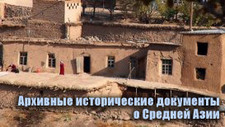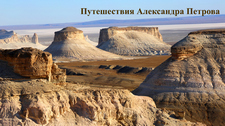Вы здесь
Bekchurin on Azret Mosque in Turkestan.
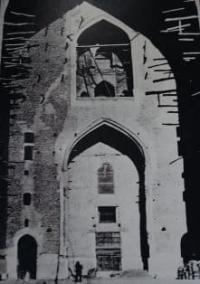
Description of Azret Mosque, located in city of Turkestan.
"There is no God but God, and Muhammad is God's ambassador. I testify that there is no God but God (one), and I also testify: Muhammad is His servant and His ambassador."
"Written by sinful slave Muhammad-Galiy, a native of the city of Kokan, in 1254 (1838)."
Visit to Azret Mosque in Turkestan.
Azret Mosque has stood for 463 years. This wondrous creation of human hands, testifying to the talent of the masters of that time, could undoubtedly serve as a model for similar artistic works today, if it better satisfied the harmonious requirements of the laws of fine art.
The mosque is located beyond the city ramparts, in a separate courtyard surrounded by a high clay wall, the corners of which are bastions of baked brick, armed with fortification guns. The courtyard is divided into two halves: the first now houses the main guardhouse and the quartermaster's office, converted from sakels (houses) in which the Turkestan hakim (commandant) lived with his family before the arrival of the Russians.
The Azret Mosque stands in the other half. The mosque's exterior is as follows: two tall minarets in front; on Fridays, the azanchi ascends one of them via a spiral internal staircase to call the faithful to prayer. Both minarets are connected by a stone wall, which forms the front of the mosque, with an external door nearby.
The top of the mosque has two uncovered domes. In the front part of the wall, several wooden beams still survive, likely used as scaffolding during the mosque's construction. The Azret Mosque is divided into three sections: the first is a huge hall, 16 fathoms high, under a dome.
To the right and left of this are four rooms each, filled with tombs. At the front of the mosque, on the left, is the door to the main mosque, which constitutes the second section, where services are held only once a week, on Friday. In the middle is a fairly large room housing the tombs of Azret and his family.
To the right of this is a long corridor with a small opening at the end, also containing tombs. From the corridor lies an entrance to a large, oblong room containing a well. In the courtyard of the Azret Mosque, in a special location, stands a separate, small, round building with a dome, covered with tiled mosaics.
It is said that Tamerlane intended to build a tomb here and transfer the body of his great-granddaughter; but this assumption was not realized due to his own death. The Azret Mosque is built of excellent baked brick on alabaster; thick wooden beams are used to connect the walls; the doors are all wooden; the roof of the large room under the dome is decorated with stucco work of alabaster; the entire mosque, including even the tops of the domes, is covered with beautiful tile mosaics; on the upper cornice, made of blue tiles, around the entire mosque is an inscription representing the text of the Koran, written in beautiful, large Arabic script, which, however, has deteriorated in many places over time, so that only the following words, located at the end, can be made out:
1. "The work of Khoja Hussein, a native of city of Shiraz."
The Azret Mosque was built by Tamerlane in 806 (according to the Muslim calendar), i.e., in 1404 A.D. Tradition has it that the following circumstance prompted its construction: the formidable conqueror's beautiful great-granddaughter, Sultan-Rabiga-Bigem, daughter of Murza-Ulus-Bek, whom Timur loved to distraction, died in her early years.
Wishing to honor her memory, he ordered a tomb and a timeless temple to be erected over Azret's grave, and buried her body next to the saint. The best craftsmen were summoned from all over the region, who labored on the construction of the temple for many years and managed to complete it almost simultaneously with Timur's death.
Inside the temple, in the aforementioned eight rooms, lived the mosque's attendants and those who came from other places to study. Subsequently, nobles of the region began to be buried in these rooms. All the Turkestan sheikhs-el-Islams, khojas, seyds, all the former hakims of the city of Turkestan, and the most venerable biys (influential figures) of the kongrat are buried here.
Besides the tomb of Sultan-Rabiga-Bigem (Tamerlane's great-granddaughter), the tombs of several Kyrgyz sultans of the Middle and Little Hordes are located here, including the famous Ablai Khan and all the ancestors of Abul-Khair, who ruled in Turkestan, and the prince of an unknown country, Baba-Samud-Yudbars-Ata.
Monuments have been erected over some of these tombs, while others are simply adorned with marble stones of various shapes and sizes, on which the names of the deceased are inscribed in beautiful Arabic script; however, their years of death are not indicated.
The walls of the first room of the Azret Mosque are filled with various inscriptions in Arabic and Persian. The inscriptions are on paper and pasted to the wall. They are partly texts from the Koran, partly spiritual verses, or the names of Muslim saints.
Here is a literal translation of the inscriptions:
2. "There is no God but God, and Muhammad is God's ambassador. I testify that there is no God but God (one), and I further testify that Muhammad is His servant and His ambassador." "Written by the sinful servant Muhammad-Gali, a native of the city of Kokan, in the year 1254 (1838)."
Below is a verse in Persian:
3. "O God! In honor of Your prophet and saint. Forgive the sins of Muhammad-Gali."
In Arabic:
4. "There is no God but God, and Muhammad is His ambassador. " May the blessing and peace of God be upon him!" "Written by the insignificant poor man, the wanderer Muhammad-Khairullah, a native of Bukhara, 1255 (1839)."
In Arabic:
5. "Say: God is one. This God, to Whom all beings turn in their needs. He neither begot nor was begotten. He has no equal in anything."
In Persian:
6. "God, Muhammad, Abubakr, Omar-Osman, Aliy." "Written by the insignificant poor man Seyid-Nazar-Khoja."
Similar inscriptions have been made in several other places by other people.
In Persian:
7. "I bow my head at Your threshold with complete desire." "If You accept... oh! what happiness that will be for me!" "Written by humble Tyurya-khodja, a native of Kani-Badam."
Also written in Arabic:
8. "Forgive his sins and destroy his vices."
These inscriptions are nothing more than samples of good handwriting, left as a memento by those pilgrims who came to venerate Azret's tomb.
In the door of the room containing Azret's tomb, verses are carved in Arabic:
9. "Door of saints is ore of happiness;" "Love for saints is key to happiness."
In the middle of the first room of the mosque, a huge copper vessel, resembling a cauldron, rises on a pedestal and can hold at least 60 buckets of water. Around it are three rows of inscriptions in various fonts, in Arabic:
1st Row:
10. "The Most High and Almighty God said: Will you place those who carry water for travelers and those who build the sacred house of prayer (on the same level as those who believe in God and in the Day of Judgment)? The Prophet, peace be upon him! said: Whoever makes a vessel for water for the sake of God, God will reward him in Paradise with a similar vessel of water. By the command of the Great Emir, the commander of those who believe in God and by God's mercy the autocrat, may God Almighty prolong his reign! This vessel for water was made for the grave of Khoja Ahmed Yasawi, the head of all the Sheikhs of Islam in the world. May God rest his holy soul! In the month of Shawwal, in the year 821 (1418)."
2nd row:
11. "Autocracy in one God."
These words are written in Kufic script.
3rd row:
12. "The work of master Abulgaziz, son of master Sharafutdin, a native of Tabriz."
According to legend, the vessel was cast in the city of Churnak, the ruins of which still stand some 50 miles from Turkestan. It is likely that this vessel held water, which was used by pilgrims living near the mosque and students in the madrasah.
Furthermore, there are four large copper candlesticks in the Azret Mosque. They also apparently had an inscription; however, it has faded in many places over time, and only the following barely surviving words in Arabic can be barely deciphered:
13. "Emir Timur of Kuryagan." "The work of Abdullah, son of Tajiddin, a native of the city of Ispaghani. "On the 20th day of the holy month of Ramadan, 799 (1397)."
The following clergy serve at the mosque:
1). Sheikh-el-Islam Nafullah-khoja-Ishak-khojin (head of all the clergy in Turkestan).
2). Gazizlyar Sharif-khoja-Bigbud-khojin (second in command after Sheikh-el-Islam).
3). Naqib Gamakber-khoja-khan-khojin (currently in Kokana).
4). Khatib Sarymak-khodsha-Gidayatullah-khojin (currently in Mecca, but expected to return soon). These two persons participate in the celebration of the cathedral service: the first as the imam (priest), the second as the vaghiz (preacher).
5). Chiragchi: Atan Niyazmuhammedov and Mukhammedkerim-Babakuzin.
6). Ferrash Redjab-Muhammed-Mir-Gashimov (all three serve as mosque attendants; the first two light the candles, and the last oversees cleanliness).
7). Muzzin (azanchi): Hasan-Sufi-Gibadullah-khodzhin (caller to prayer from the minaret).
The Azret Mosque is of great religious significance in the region. Muslims (Sunni) consider it a sacred temple, to which, before the Russian conquest of Turkestan, pilgrims are said to have flocked from all over Asia. Even emirs, khans, and other nobles came, making large donations to the students of the mosque's madrasah and the clergy.
The income of the Azret Mosque and its clergy, in addition to donations, consists of:
1). cash collections from two guest houses and one caravanserai. The guest houses were the property of the former Turkestan hakim, Sheikh-Badam-Sheikh-Khojiyev, who died at the age of 40. During his lifetime, he converted them into a waqf (charitable endowment) for the Azret Mosque.
His son, Mutavalliy (manager) Ataullah-Khoja, leased all the shops located in these guest houses to local merchants and spent the proceeds as follows:
Of the total amount, he retained 1/10th for his own upkeep. Of the remaining funds, 1/3 is allocated for the upkeep of mudarris (teachers) at schools located in the city of Turkestan; the remainder, after all these expenses, is donated to the Azret Mosque, 10 tenge every Monday.
2). The caravanserai (special courtyard for caravans) has only 80 shops, which are rented out to merchants temporarily staying in Turkestan, for which approximately 100 till are earned annually. This money, with the exception of 1/10, which goes to the Sheikh el-Islam of Turkestan, is used for the repair of the Azret Mosque.
3). All land along the Urtak irrigation ditch is given over to quitrent, and for this, the following is collected annually:
a). One batman for every five harvested millet, wheat, and barley.
b). From bakcha and orchards, 10 tenge per tanab.
c). From clover, 5 tenge per tanab.
All this income is tabulated and then distributed among three persons attached to the Azret Mosque: the sheikh-el-islyam, the gazizlyar, and the naqib.
4). All land along the Syuyri-aryk (the name of a ditch) is granted exclusively to the clergy of the Azret Mosque and all their relatives and friends, who either sow grain, clover, etc., there themselves, or give their share to outsiders for a nominal fee.
5). The Khan of Kokan, before the capture of Turkestan, annually sent 500 till (chervonets) of his own money, and in addition, many other benefactors donated money and goods. All this, according to the accepted rule, also benefited the aforementioned three individuals, as senior representatives of the clergy at the Azret Mosque.
6). Many of the pilgrims donate rams, which are slaughtered once a week, on Fridays, and their meat is distributed to the poorest residents of Turkestan and to pilgrims.
The Azret Mosque was repaired only once, during the reign of the Bukhara Emir Abdullah Khan, at a time when the city of Turkestan was still dependent on Bukhara. Emir Abdullah Khan ordered the construction of a small, mezzanine-like chapel over the mosque's outer door, in its wall, serving no purpose.
Although he did repair the mosque itself externally, it was very poorly done. Those areas of the mosque's exterior walls where cracks had developed due to exposure to the elements or tiles had fallen out are still simply plastered over with alabaster, resulting in a rather unpleasingly motley appearance.
During the assault on the city of Turkestan, the Azret Mosque also suffered damage. Since its bastions were armed with cannons and hindered our troops' advance, the commander of the Russian detachment, in order to knock them down and thus hasten the capture of the city, first intended to destroy the Azret Mosque, which stood in an open and elevated position, very convenient for bombardment.
Several destructive shells were fired at it, most of which, passing over the mosque's domes, left marks in eleven places, four of which even pierced the top. The mosque would undoubtedly have been completely destroyed, or at least would have suffered much more, if the Sheikh el-Islam, disregarding the danger that threatened him, had not hastened to climb the minaret himself and raised a white flag, a harbinger of the surrender of the city.
The damage has still not been repaired. If left in this state, it will inevitably contribute, when exposed to air, to the rapid destruction of the ancient temple: already now, due to dampness penetrating through the holes, the plaster beneath the domes has begun to peel.
Comments.
1. Azret, more correctly Hazret-Khoja-Ahmed-Yasavi, a great Muslim saint and head of a sect professed by all Muslims of Central Asia, Turks, and all classes of Muslims subject to Russia, died in 514 (according to the Muslim calendar), i.e., in 1120 A.D.; the mosque over his grave was erected 284 years after his death.
2. A view of the Azret Mosque, as well as photographs of the more remarkable inscriptions preserved on its walls, are included at the end of the article.
3. More on this below.
4. See Appendix.
5. Mirza Ulugh Beg (son of Shah Rukh Mirza), grandson of Timur the Great, was a passionate astronomer. He built a madrasah in Samarkand in 828 (1425) and a similar one in Bukhara, which are still known by his name.
6. Timur was born in 736 (1335) and died in 807 (1405). Here is Timur's genealogy, from his biography in Persian: Karachar Nuyan - Emir Iljr - Emir Ilenghiz - Emir Birkel - Emir Turagai - Emir Timur.
7. Head of the clergy.
8. Members of an ancient noble family who trace their lineage back to the Prophet himself. They form the upper class in the east and are highly respected by the people.
9. The Kirghiz nomads who roam the Amu Darya River, in the area between the cities of Bukhara, Karshi, and Kusk, are known by the common name of Kongrat. These Kirghiz are engaged in livestock breeding, primarily sheep farming. Bukhara, Samarkand, and other populous cities obtain their rams exclusively from them.
10. Ablai was confirmed as Khan of the Middle Horde by an imperial charter on October 22, 1778, and died in 1781.
11. Abul-Khair Khan of the Lesser Horde, who submitted to the Russian scepter in 1731. He was killed by Sultan Barak in 1748 and buried in the Karakalpak nomad camps near the Caspian Sea. Abul-Khair lived in the city of Turkestan, and in 1723 he was expelled from there by Gildan-Tsyren, the ruler of Dzungaria.
12. This text is written by the hand of Muhammad-Galiy, the former Khan of Kokan, who is said to have been an excellent calligrapher. This Khan and almost all members of his family (his brother and two sons) were killed by the Bukhara Emir Nasrulda-Bagadur Khan in 1842, during the latter's capture of Kokan.
13. It speaks of those who do not believe in the true God.
14. This inscription contains only half a verse, and therefore, for greater clarity, I have placed the translation of the full verse of the Koran in parentheses.
15. Timur's title.
16. Madrasah - an institution of higher education; Lower educational institutions are called mektebs.
17. The village of Kuryagan, Tamerlane's birthplace, was located in Central Asia, near the city of Shagri-Syabz, not far from Samarkand, where the hero is buried.
18. A waqf is any property (land, shops, etc.) the owner of which, in the presence of senior government officials, bequeaths it in writing to some government or private company. If the deed of gift is made in favor of a madrasah or mosque, which is most often the case, then the beneficiary must indicate how the income from the waqf is to be distributed among the clergy.
19. The tenga, also known as kukan, is a silver coin minted in Kokan, equal to our twenty-grivennik; the copper coin, chaka, is equal to 1/2 a silver kopeck. Ten chakas make a meri, equal to 5 silver kopecks.
20. Tilliya, a gold coin of the same mintage, circulates in 3 rubles, 80 silver coins.
21. Aryk means a ditch dug to channel water from the Syr Darya and other rivers. In the Turkestan region, ditches are essential for irrigation; therefore, water is supplied to all fields and plantations through ditches.
22. The Turkestan batman contains exactly 8 poods, the Tashkent batman = 10.5 poods, and the Bukhara batman = 7 poods, 32 pounds, 48 gold. In eastern Turkestan, under Chinese rule, the batman = 21 poods, 12 pounds.
23. Tanab is a dessiatine of 40 square fathoms.
24. Clover is one of the grasses cultivated in the Turkestan region using irrigation. Its cultivation is given great attention here because it provides nutritious fodder for livestock. Sown in the spring, clover is harvested three times a summer, sometimes four; with intensive irrigation, it can be harvested up to five times a summer.
Clover is not mown here, but reaped with sickles and tied into sheaves, like wheat. A tanab yields about a thousand sheaves, and clover is usually sold at the market in sheaves. Its price varies depending on time and place. Last fall, clover was sold at the market in the city of Turkestan for 2 kopecks per sheaf, and for a hundred, they asked me 1 ruble 80 kopecks. In the summer, however, as the natives told me, you can buy it for 1 kopeck per sheaf and even 80 kopecks per hundred. In areas with active trade, clover sells for much more. The local name for clover is dzhungurchka.
25. The city of Turkestan was under the control of the Kirghiz-Kaisaks in the XVIth century. In 1630, Ishim, the son of Shigai Khan, ruled there. His descendants ruled here until 1723, when the city was captured by the Dzonggars. After that, Turkestan was briefly part of the Bukhara Khanate; from 1814 to 1863, that is, until its occupation by the Russians, it was ruled by the Kokan khans.

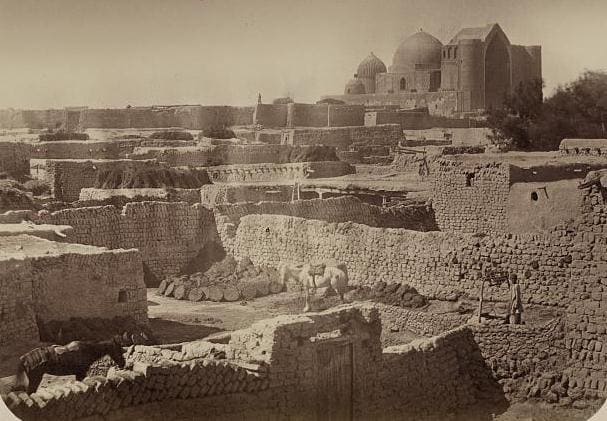
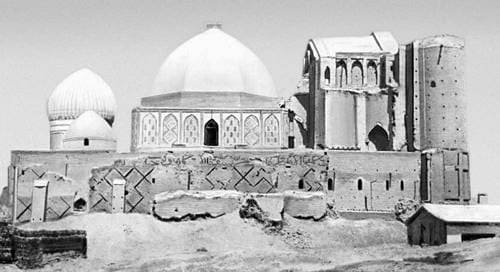
Authority:
Mir-Salih Bekchurin. City of Orenburg. February 19, 1866.





